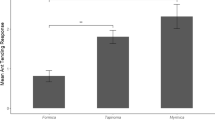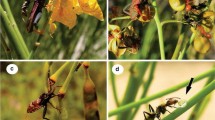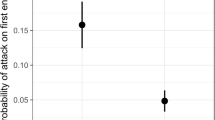Summary
The larvae and pupae of the Australian lycaenid butterfly, Jalmenus evagoras associate mutualistically with ants in the genus Iridomyrmex. Four ant exclusion experiments in three field sites demonstrated that predation and parasitism of J. evagoras are so intense that individuals deprived of their attendant ants are unlikely to survive. Larvae and pupae of J. evagoras aggregate, and the mean number of attendant ants per individual increases with larval age and decreases with group size. Field observations showed that young larvae could gain more attendant ants per individual by joining the average size group of about 4 larvae than by foraging alone. Aggregation behaviour is influenced by ant attendance: young larvae and pupating fifth instars aggregated significantly more often on plants with ants than on plants where ants had been excluded. In return for tending and protecting the larvae, ants were rewarded by food secretions that can amount to as much as 409 mg dry biomass from a single host plant containing 62 larvae and pupae of J. evagoras over a 24 h period. Larval development in the laboratory lasted approximately a month, and larvae that were tended by ants developed almost 5 days faster than larvae that were not tended. However, tended individuals, particularly females, pupated at a significantly lower weight than their untended counterparts, and the adults that eclosed from these pupae were also lighter and smaller. On average, pupae that were tended by ants lost 25% more weight than untended pupae, and in contrast with larvae, they took longer to eclose than pupae that were not tended. These experimental results are discussed in terms of costs and benefits of association for both partners, and of aggregation for the lycaenids.
Similar content being viewed by others
References
Addicott JF (1984) Mutualistic interactions in population and community processes. In: Price PW, Slobodchikoff CN, Gaud BS (eds) A new ecology: novel approaches to interactive systems. Wiley, New York, pp 437–455
Addicott JF (1986a) On the population consequences of mutualism. In: Diamond J, Case TJ (eds) Community ecology. Harper and Row, New York
Addicott JF (1986b) Variation in the costs and benefits of mutualism: the interaction between yuccas and yucca moths. Oecologia (Berl) 70:486–494
Atsatt PR (1981) Lycaenid butterflies and ants: selection for enemy-free space. Am Nat 118:638–654
Axelrod R (1984) The evolution of cooperation. Basic Books, New York
Axelrod R, Hamilton WD (1981) The evolution of cooperation. Science 211:1390–1396
Bhatkar A, Whitcomb WH (1970) Artificial diet for rearing various species of ants. The Fla Entomol 53:230–232
Boucher DH (1985) The idea of mutualism, Past and Future. In: Boucher DH (ed) The biology of mutualisms. Croom Helm, Kent
Boucher DH, James S, Keeler KH (1982) The ecology of mutualism. Ann Rev Ecol Syst 13:315–347
Common IFB, Waterhouse DF (1981) Butterflies of Australia, 2nd edn. Angus and Robertson, Sydney
Cottrell CB (1984) Aphytophagy in butterflies: its relationship to myrmecophily. Zool J Linn Soc 79:1–57
Downey JC (1962) Myrmecophily in Plebejus (Icaricia) icarioides (Lepidoptera: Lycaenidae). Entomol News 73:57–66
Dunn KL (1984) Acacia diffusa Lind.: a new larval foodplant for Jalmenus evagoras evagoras (Donovan) (Lepidoptera: Lycaenidae). Vict Entomol 14:8
Elgar MA, Pierce NE (1987) Mating success and fecundity in an ant-tended lycaenid butterfly. In: Clutton-Brock TH (ed) Reproductive success: studies of selection and adaptation in contrasting breeding systems. Chicago University Press, Chicago (in press)
Hawkeswood TJ (1981) The food plants of Jalmenus evagoras (Donovan) (Lepidoptera: Lycaenidae). Aust Entomol Mag 8:1–2
Henning SF (1983) Chemical communication between lycaenid larvae (Lepidoptera: Lycaenidae) and ants (Hymenoptera: Formicidae). J Entomol Soc South Afr 46:341–366
Hinton HE (1951) Myrmecophilous Lycaenidae and other Lepidoptera — a summary. Proc Soc Lond Entomol Nat Hist Soc 1951:111–175
Hölldobler B (1970) Zur Physiologie der Gast-Wirt-Beziehungen (Myrmecophilie) bei Ameisen. II. Das Gastverhältnis zu Myrmica und Formica. Z Vergl Physiol 66:215–250
Hölldobler B (1971) Communication between ants and their guests. Sci Amer 224:86–93
Janzen DH (1979) How many babies do figs pay for babies? Biotrop 11:48–50
Janzen DH (1985) The natural history of mutualisms. In: Boucher DH (ed) The biology of mutualism. Croom Helm, London, pp 40–99
Keeler KH (1981) A model for a facultative, non-symbiotic mutualism. Am Nat 118:488–498
Keeler KH (1985) Cost: benefit models of mutualism. In: Boucher DH (ed) The biology of mutualism. Croom Helm, London, pp 100–127
Kitching RL (1981) Egg clustering and the Southern Hemisphere lycaenids: comments on a paper by N.E. Stamp. Am Nat 118:423–425
Kitching RL (1983) Myrmecophilous organs of the larvae and pupae of the lycaenid butterfly Jalmenus evagoras (Donovan). J Nat Hist 17:471–481
Kitching RL, Luke B (1985) The myrmecophilous organs of the larvae of some British Lycaenidae (Lepidoptera): a comparative study. J Nat Hist 19:259–276
Kitching RL, Taylor MFJ (1981) The culturing of Jalmenus evagoras (Donovan) and its attendant ant, Iridomyrmex anceps (Roger). Aust Ent Mag 7:71–75
Malicky H (1969) Versuch einer Analyse der ökologischen Beziehungen zwischen Lycaeniden (Lepidoptera) und Formiciden (Hymenoptera). Tijdschr Entomol 112:213–298
Malicky H (1970) New aspects on the association between lycaenid larvae (Lycaenidae) and ants (Formicidae, Hymenoptera). J Lepid Soc 24:190–202
Maschwitz U, Wust M, Schurian K (1975) Blaulingsraupen als Zuckerlieferanten für Ameisen. Oecologia (Berl) 18:17–21
Maynard Smith J (1982) Evolution and the theory of games. Cambridge University Press, Cambridge
Morse D (1985) Costs in a milkweed, Asclepias syriaca and bumblebee, Bombus spp. mutualism. Am Nat 125:903–905
Nijhout HF (1975) A threshold size for metamorphosis in the tobacco hornworm, Manduca sexta (L.). Biol Bull 149:214–225
Nijhout HF (1981) Physiological control of molting in insects. Am Zool 21:631–640
Nijhout HF, Williams CM (1974a) Control of moulting and metamorphosis in the tobacco hornworm, Manduca sexta (L.): Growth of the last-instar larva and the decision to pupate. J Exp Biol 61:481–491
Nijhout HF, Williams CM (1974b) Control of moulting and metamorphosis in the tobacco hornworm, Manduca sexta (l.): cessation of juvenile hormone secretion as a trigger for pupation. J Exp Biol 61:493–501
Pierce NE (1983) The ecology and evolution of symbioses between lycaenid butterflies and ants. PhD thesis, Harvard University, Cambridge
Pierce NE (1984) Amplified species diversity: a case study of an Australian lycaenid butterfly and its attendant ants. In: Vane Wright RI, Ackery PR (eds) Biology of butterflies. XI Symp R Entomol Soc (Lond). Academic Press, London, pp 197–200
Pierce NE (1985) Lycaenid butterflies and ants: selection for nitrogen fixing and other protein rich food plants. Am Nat 125:888–895
Pierce NE (1987) The evolution and biogeography of associations between lycaenid butterflies and ants. Oxford Surv Evol Biol (in press)
Pierce NE, Easteal S (1986) The selective advantage of attendant ants for the larvae of a lycaenid butterfly, Glaucopsyche lygdamus. J Anim Ecol 55:451–462
Pierce NE, Elgar MA (1985) The influence of ants on host plant selection by Jalmenus evagoras, a myrmecophilous lycaenid butterfly. Behav Ecol Sociobiol 16:209–222
Pierce NE, Mead PS (1981) Parasitoids as selective agents in the symbiosis between lycaenid buterfly caterpillars and ants. Science 211:1185–1187
Pierce NE, Young WR (1987) Lycaenid butterflies and ants: two-species stable equilibria in mutualistic, commensal, and parasitic interactions. Am Nat 128 (in press)
Ross GN (1966) Life history studies on Mexican butterflies. IV. The ecology and ethology of Anatole rossi, a myrmecophilous metalmark (Lepidoptera: Riodinidae). Ann Entomol Soc Am 59:985–1004
Roughgarden J (1975) Evolution of marine symbiosis—a simple cost-benefit model. Ecol 56:1201–1208
Schemske DW (1983) Limits to specialization and coevolution in plant-animal mutualisms. In: Nitecki MH (ed) Coevolution. Univ of Chicago Press, Chicago
Templeton AR, Gilbert LE (1985) Population genetics and the coevolution of mutualism. In: Boucher DH (ed) The biology of mutualism. Croom Helm, London, pp 128–144
Trivers RL (1971) The evolution of reciprocal altruism. Q Rev Biol 46:35–57
Vandermeer J (1984) The evolution of mutualism. In: Shorrocks B (ed) Evolutionary ecology. Symp Brit Ecol Soc, 23. Blackwell, London, pp 221–232
Vane Wright RI (1978) Ecological and behavioural origins of diversity in butterflies. In: Mound LA, Waloff N (eds) Diversity of insect faunas. IX Symp R Entomol Soc (Lond). Blackwell, London, pp 56–59
Way MJ, Cammell M (1970) Aggregation behaviour in relation to food utilisation by aphids. In: Watson A (ed) Animal populations in relation to their food resources. Blackwell, Oxford, pp 229–247
Wilson DS (1980) The natural selection of populations and communities. Benjamin/Cummings, Menlo Park
Wilson DS (1983) The effects of population structure on the evolution of mutualism: a field test involving burying beetles and their phoretic mites. Am Nat 121:851–870
Wolin CL (1985) The population dynamics of mutualistic systems. In: Boucher DH (ed) The biology of mutualism. Croom Helm, London, pp 248–269
Author information
Authors and Affiliations
Rights and permissions
About this article
Cite this article
Pierce, N.E., Kitching, R.L., Buckley, R.C. et al. The costs and benefits of cooperation between the Australian lycaenid butterfly, Jalmenus evagoras, and its attendant ants. Behav Ecol Sociobiol 21, 237–248 (1987). https://doi.org/10.1007/BF00292505
Received:
Accepted:
Issue Date:
DOI: https://doi.org/10.1007/BF00292505




